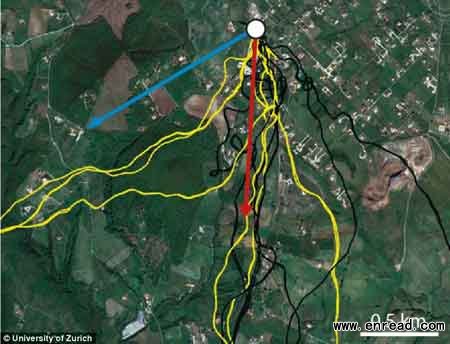鸽子大脑中有一幅空间地图
Scientists believe that pigeons have a spatial map that allows them to fly in an unfamiliar territory and know exactly where they are going.
科学家经过实验得出结论:鸽子大脑中有一幅空间地图,因而能够在陌生地区飞行,并能判断出确切的飞行方向。

蓝箭头指示喂食鸽房的方向,红箭头指示鸽房方向,白点为放飞地点。黄色表示饥饿鸽子的飞行路线,黑色表示喂过食鸽子的飞行路线。
The finding replaces the current theory that pigeons compare the coordinates of their location with those of the home loft and then systematically reduce the difference between the two to find their way home.
This earlier theory likens the navigation of pigeons to that of flying robots.
But experiments carried out at the University of Zurich have shown that pigeons possess cognitive capabilities.
In unknown areas, the scientists claim pigeons recognise where they are in relation to their home loft and are able to choose their targets themselves.
Homing pigeons and migratory birds determine their flight direction with the help of the Earth's magnetic field, the stars and the position of the sun.
Nicole Blaser, a doctoral student in biology at the University of Zurich proposed the theory that pigeons have a spatial understanding and knowledge of their position in space relative to their home loft.
This theory presupposes a type of mental map in their brain and thus cognitive capabilities. Up until now, there has not been any clear evidence to support this.
For their experiments, Blaser and her colleagues fitted homing pigeons with miniature GPS loggers in order to monitor the birds' flight paths.
Beforehand the researchers trained the pigeons not to obtain food in the home loft, as was normally the case otherwise.
'We fed the pigeons in a second loft around thirty kilometres away, from where they each had to fly back to their home loft', said Blaser, explaining the structure of the experiment.
The scientists then brought the pigeons to a third place unknown to the pigeons in completely unfamiliar territory.
This release site was in turn 30 kilometres from the home loft and the food loft. Natural obstacles obscured visual contact between the release site and the two lofts.
One group of the pigeons was allowed to eat before flying home. The other group was kept hungry before starting off.
'We wanted to find out whether the hungry pigeons fly first to the home loft and from there to the food loft or whether they are able to fly directly to the food loft,' said Blaser.
'As we expected, the satiated pigeons flew directly to the home loft', said professor Hans-Peter Lipp, neuroanatomist at the University of Zurich.
'They already started on course for their loft and only deviated from that course for a short time to make topography(地势)-induced detours(绕路,便道).'
The hungry pigeons behaved differently, setting off on course for the food loft from the very beginning and flying directly to that target.
They also flew around topographical obstacles and then immediately adjusted again to their original course.
Based on this evidence, Blaser believes that pigeons can determine their location and their direction of flight relative to the target and can choose between several targets.
Blaser concluded that pigeons have a type of cognitive navigational map in their heads and have cognitive capabilities.
'Pigeons use their heads to fly', she said.